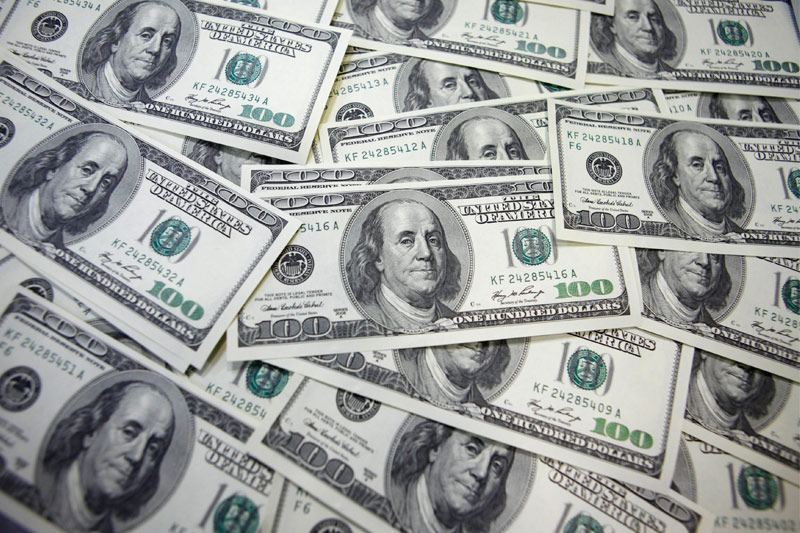Investing.com -- The U.S. Dollar Index pared sharp losses, remaining near three-month highs, after the release of a closely-watched Federal Reserve survey on Wednesday and ahead of a highly-anticipated interest rate decision from the Bank of England.
The index, which measures the strength of the greenback versus a basket of six major currencies, hit an intraday low of 96.09 before, rebounding to 96.36 (down 0.19 or 0.20%) at the close of U.S. afternoon trading. At session-highs of 96.60, the index was only down fractionally from its three-month high in late-June in the wake of the post-Brexit fallout. Although the dollar has fallen sharply from its peak in December, it has rallied more than 4% from its level in early-May when it slumped to 10-month lows.
When the Federal Reserve released the latest version of its Beige Book on Wednesday afternoon, the survey showed evidence of modest economic growth in most regions of the U.S. for the monthly period through July 1. At the same time, respondents from the 12 Fed district reported indications of modest employment growth, modest to moderate wage pressures and generally positive levels of consumer spending, despite some signs of softening conditions. While three regions, Dallas, Chicago and Boston said last month's U.K. referendum had an effect on business activity in their areas, none of the other districts made note of Britain's decision to leave the European Union.
Over the last few weeks, members of the Federal Open Market Committee (FOMC) appear split on the timing of the Fed's next interest rate hike. Kansas City Fed president Esther George and Cleveland president Loretta Mester appear to favor gradual rate hikes over the medium term, while St. Louis Fed president James Bullard and Minnesota Fed president Neel Kashkari seem to advocate a patient approach to tightening monetary policy. Dallas Fed president Rob Kaplan, meanwhile, said the FOMC can remain accommodative as long as its dual mandate in terms of inflation and employment objectives are not met. Also, Philadelphia Fed president Patrick Harker said on Wednesday that the FOMC could still raise rates up to two times this year.
In the U.K., Home Secretary Theresa May was confirmed as Britain's second-ever female prime minister and 54th in history after David Cameron officially resigned from the position on Wednesday. While it is unclear if May's appointment will boost the U.K.'s chances of gaining access to the European Union's single market, the move helped ease investor sentiments on the strength of the British economy for the time being.
Also on Wednesday, May reshuffled Cameron's cabinet appointing former London mayor Boris Johnson as foreign secretary, while adding David Davis, as Secretary of State for Exiting the European Union. Johnson replaces Philip Hammond, who was appointed as chancellor of the exchequer, following the dismissal of George Osborne. The moves come ahead of Thursday's closely-watched Bank of England meeting, the first since the Brexit decision. While BOE governor Mark Carney has sent strong indications that the bank could lower rates and unveil a fresh round of easing at some point this summer, Carney has hinted that the BOE could wait until August before instituting the measures.
GBP/USD hit near two-week highs of 1.337 on Wednesday, before falling back to 1.3133 at the close of U.S. afternoon trading.
Elsewhere, investors digested conflicting reports that Japan could adopt a helicopter monetary policy following former Federal Reserve chair Ben Bernanke's meeting with Abe on Tuesday in Tokyo. The concept of helicopter money involves large scale printing of money by a central bank that is distributed to the public as a way for helping stimulate the economy. Abe unveiled a sweeping reform after his Liberal Democratic Party (LDP) triumphed in upper-house elections over the weekend, which includes a ¥10 trillion ($98 billion) stimulus plan.
In addition, the Japanese government lowered its annual March, 2017 consumer inflation forecast from 1.2 to 0.4% on Wednesday. As a result, the dollar pared earlier losses against the Yen, trading at 104.32 at the end of the U.S. afternoon session, down 0.17% on the day. The pair slipped below 104.00 at session-lows, one day after hitting a two-week high at 104.98.
